Serving 758 students in grades Prekindergarten-5, Trace Crossings Elementary School ranks in the top 20% of all schools in Alabama for overall test scores (math proficiency is top 10%, and reading proficiency is top 10%).
The percentage of students achieving proficiency in math is 53% (which is higher than the Alabama state average of 29%). The percentage of students achieving proficiency in reading/language arts is 64% (which is higher than the Alabama state average of 47%).
The student:teacher ratio of 15:1 is lower than the Alabama state level of 17:1.
Minority enrollment is 57% of the student body (majority Black), which is higher than the Alabama state average of 49% (majority Black).
Quick Stats (2025)
- Grades: Prekindergarten-5
- Enrollment: 758 students
- Student:Teacher Ratio: 15:1
- Minority Enrollment: 57%
- Overall Testing Rank: Top 20% in AL
- Math Proficiency: 53% (Top 10%)
- Reading Proficiency: 64% (Top 20%)
- Science Proficiency: 45-49% (Top 30%)
- Source: National Center for Education Statistics (NCES), AL Dept. of Education
Top Rankings
Trace Crossings Elementary School ranks among the top 20% of public schools in Alabama for:
Category
Attribute
Overall Rank
Math Proficiency
Reading/Language Arts Proficiency
Diversity
Student Attention
School Overview
Trace Crossings Elementary School's student population of 758 students has grown by 6% over five school years.
The teacher population of 50 teachers has grown by 6% over five school years.
Grades Offered
Grades Prekindergarten-5
Total Students
758 students
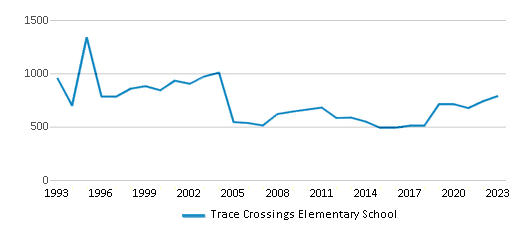
Gender %
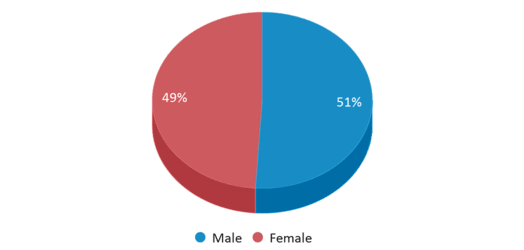
Total Classroom Teachers
50 teachers
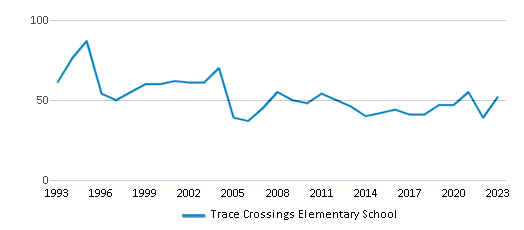
Students by Grade
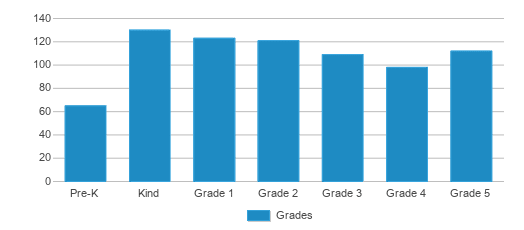
School Rankings
Trace Crossings Elementary School ranks within the top 20% of all 1,285 schools in Alabama (based off of combined math and reading proficiency testing data).
The diversity score of Trace Crossings Elementary School is 0.69, which is more than the diversity score at state average of 0.63. The school's diversity has stayed relatively flat over five school years.
Overall Testing Rank
#144 out of 1285 schools
(Top 20%)
(Top 20%)
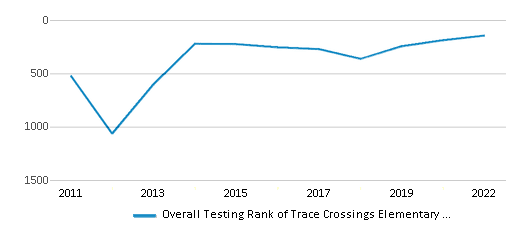
Math Test Scores (% Proficient)
53%
29%
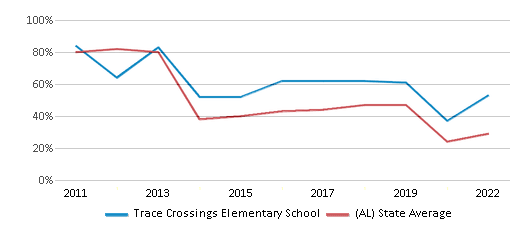
Reading/Language Arts Test Scores (% Proficient)
64%
47%
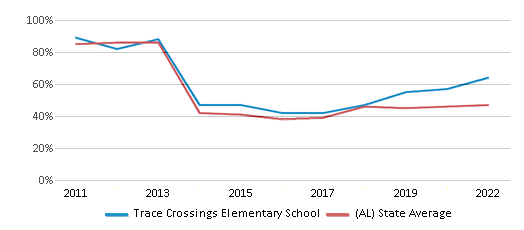
Science Test Scores (% Proficient)
45-49%
38%
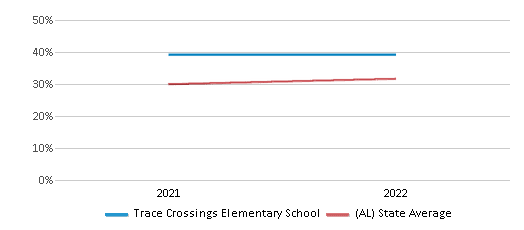
Student : Teacher Ratio
15:1
17:1
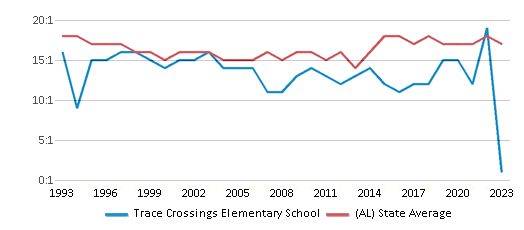
American Indian
n/a
1%
Asian
10%
1%
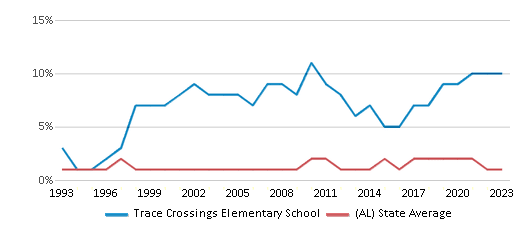
Hispanic
7%
11%
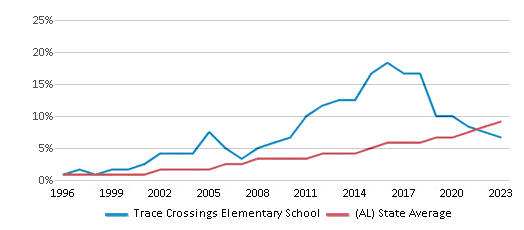
Black
34%
32%
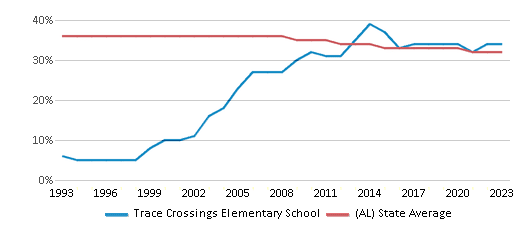
White
43%
51%
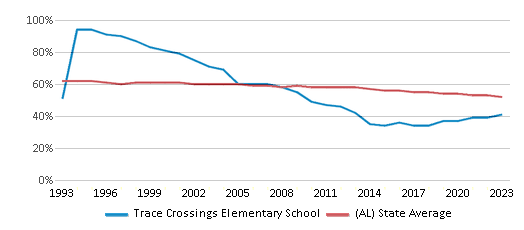
Hawaiian
n/a
n/a
Two or more races
6%
4%
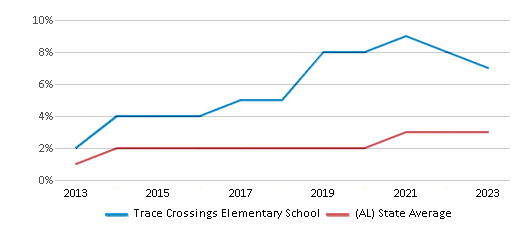
All Ethnic Groups
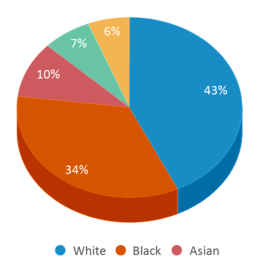
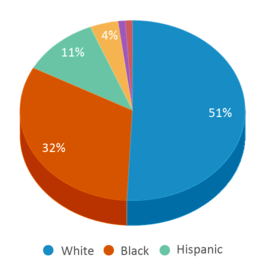
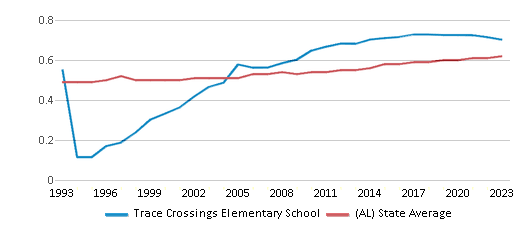
Participates in the National School Lunch Program (NSLP)
Yes
Eligible for Free Lunch
34%
56%
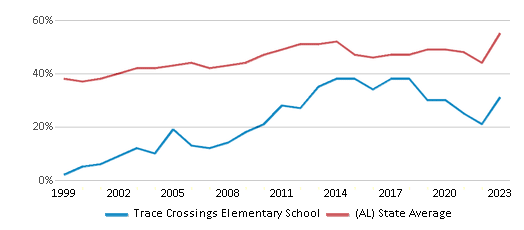
Eligible for Reduced Lunch
4%
5%
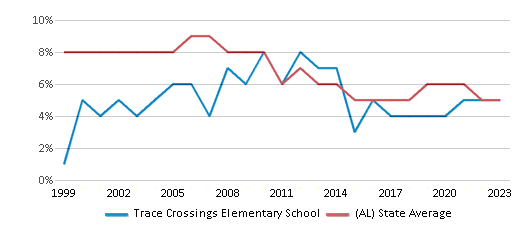
School Statewide Testing
School District Name
Source: National Center for Education Statistics (NCES), AL Dept. of Education
Profile last updated: 02/09/2025
Frequently Asked Questions
What is Trace Crossings Elementary School's ranking?
Trace Crossings Elementary School is ranked #144 out of 1,285 schools, which ranks it among the top 20% of public schools in Alabama.
What schools are Trace Crossings Elementary School often compared to?
Trace Crossings Elementary Schoolis often viewed alongside schools like Green Valley Elementary School, Bluff Park Elementary School, Deer Valley Elementary School by visitors of our site.
What percent of students have achieved state testing proficiency in math and reading?
53% of students have achieved math proficiency (compared to the 29% AL state average), while 64% of students have achieved reading proficiency (compared to the 47% AL state average).
How many students attend Trace Crossings Elementary School?
758 students attend Trace Crossings Elementary School.
What is the racial composition of the student body?
43% of Trace Crossings Elementary School students are White, 34% of students are Black, 10% of students are Asian, 7% of students are Hispanic, and 6% of students are Two or more races.
What is the student:teacher ratio of Trace Crossings Elementary School?
Trace Crossings Elementary School has a student ration of 15:1, which is lower than the Alabama state average of 17:1.
What grades does Trace Crossings Elementary School offer ?
Trace Crossings Elementary School offers enrollment in grades Prekindergarten-5
What school district is Trace Crossings Elementary School part of?
Trace Crossings Elementary School is part of Hoover City School District.
School Reviews
5 8/20/2019
We are finishing our first year at TCES and it has been a phenomenal experience. I was nervous about transferring him to TCES because of the negative reputation it's had in the past, but I have been nothing but impressed. We've had a wonderful, experienced teacher (Mrs. Walker) who has done a great job meeting my child's academic needs. My child is in the Enrichment Program and has loved Mrs. Tofani because she supports his creativity and imagination. The school's guidance counselor, Mrs. Coleman, is always supportive when my child drops by to talk to her. I admire the leadership from Principal Collins and I am impressed with his calm and caring nature. I have enjoyed all of the activities hosted by the school for parents and children- PTO, College and Career Day, Family Fun Night, student Art Show, and more. Trace Crossings is a gem and I am thrilled that we have two more years there!
Review Trace Crossings Elementary School. Reviews should be a few sentences in length. Please include any comments on:
- Quality of academic programs, teachers, and facilities
- Availability of music, art, sports and other extracurricular activities
Recent Articles

What Is A Charter School?
Explore the world of charter schools in this comprehensive guide. Learn about their history, how they operate, and the pros and cons of this educational innovation. Discover key facts about charter schools, including admission policies, demographics, and funding, as well as what to look for when considering a charter school for your child.

10 Reasons Why High School Sports Benefit Students
Discover the 10 compelling reasons why high school sports are beneficial for students. This comprehensive article explores how athletics enhance academic performance, foster personal growth, and develop crucial life skills. From improved fitness and time management to leadership development and community representation, learn why participating in high school sports can be a game-changer for students' overall success and well-being.

February 05, 2025
Understanding the U.S. Department of Education: Structure, Impact, and EvolutionWe explore how the Department of Education shapes American education, from its cabinet-level leadership to its impact on millions of students, written for general audiences seeking clarity on this vital institution.







